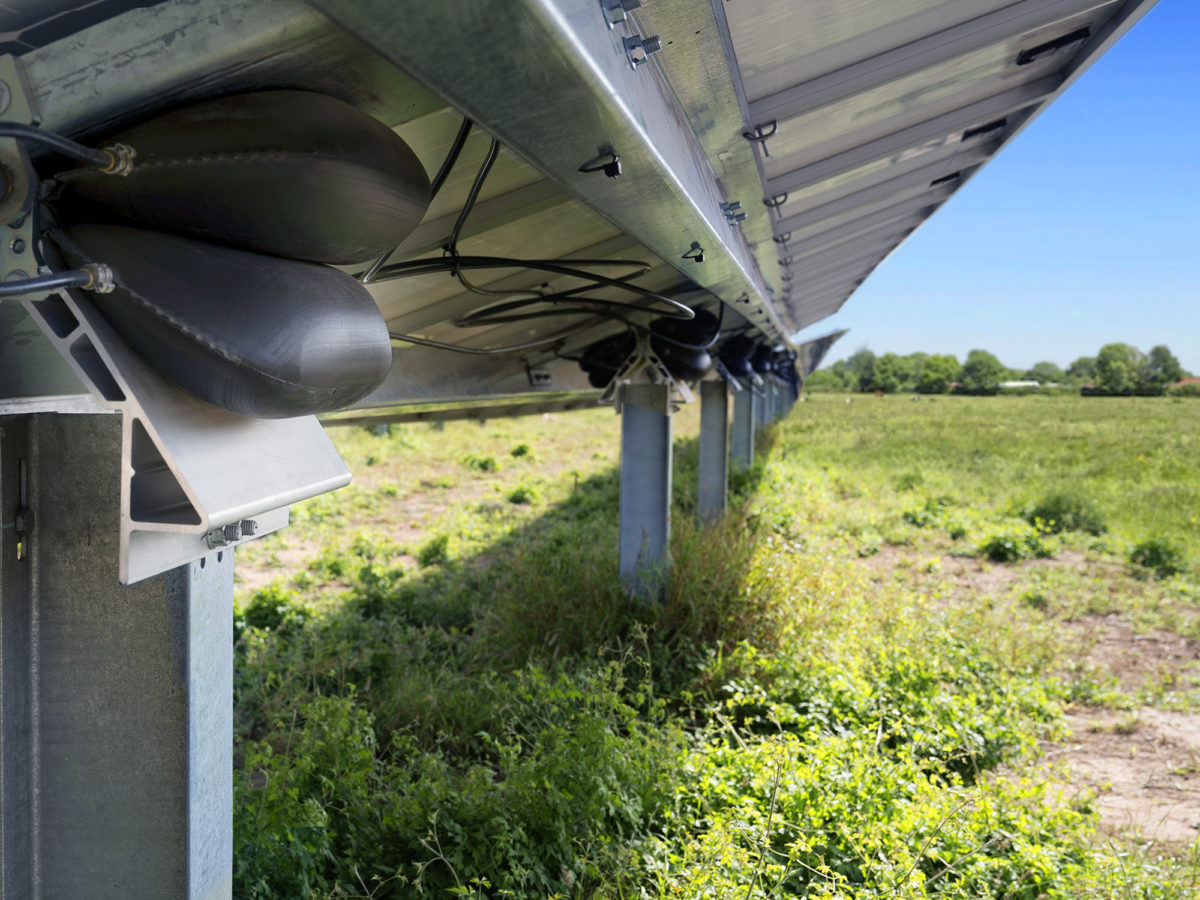From pv magazine USA.
Sometimes the best way to gain attention in a crowded market is to go entirely against the grain and carve your own niche, an idea both known to and embraced by US-based tracker manufacturing startup, Sunfolding.
In this regard, the company has found success by eschewing existing single-axis tracker technology, instead creating a solar tracker powered by air that has brought with it $32 million in funding and an ever-growing project pipeline.
The company’s flagship product is the T29 solar tracker, which is powered by air pneumatics. Rather than using a traditional motor, the system instead has two flexible bladders, aligned east-west, contained in a metal housing unit. Over the course of the day, the bladders are inflated, tilting the module above to the opposite direction, allowing it to track the sun.
The solution allows for a significant reduction in parts within the system and an accompanying reduction in weight. The system also improves efficiencies across material distribution, maintenance and installation time, while also allowing for installations on land areas that may have been otherwise unusable.
The pneumatic technology behind the T29 is something Sunfolding is so confident in, that the company recently published a white paper outlining air pneumatics’ unrecognized potential.
Ease of construction
“Because we’ve really simplified the process, we have a lot of advantages on the construction side.” VP of Marketing, Gwen Rose, told pv magazine. “One of our other big value propositions is that we have three unique components in the field and two bolt sizes, so you don’t need any specialized tools and there’s a certain repeatability to the construction steps that really simplifies the whole process… Because we basically have a post, an actuator – which does all of the work that a torque-tube motor, bearing and gearbox would do – and the racking that the module sits on, it’s repeatable and uniform.”
Beyond just improving the simplicity of installations, Rose sees one of the biggest advantages that Sunfolding has over competitors as being the increased amount of terrains the solution can be installed on.
Popular content
“There’s this underserved opportunity to meet projects that are on challenging terrain,” Rose said. “Most of the companies that we talk to have this underlying assumption that if you’re going to be developing projects on a more challenging topography, that it’s going to cost more. We’ve actually had to teach them that’s not actually the case.”
And that’s where the second aspect of the system’s design comes into play: installation flexibility.
“Because we have this really flexible tracker span, we do hills, we can stair-step and get really close to a road and it doesn’t cost us more to do it,” said Rose. “That’s one of the core values of Sunfolding: because we have this really flexible tracker span, we can do really challenging topographies without a cost associated with it… It’s really a different approach. Show us your site and let us tell you how we’re going to leave it alone, but still get the same amount of capacity as any other tracker, or more.”
This idea of a simple, flexible system is one that has been built not out of curiosity or happenstance, but by a perceived necessity alongside the growth of the solar market.
“We’re running out of large, square, perfectly-flat pieces of land,” said Rose.
What’s next for Sunfolding
The company plans to use its Series B funding to expand its US-based manufacturing and assembly footprint and increase volume purchasing power with suppliers, including vendors in the automotive industry. The additional funds will also support the growth of Sunfolding’s team to execute on more large-scale solar projects concurrently.
Sunfolding’s average project size is in the 10 to 40 MW range right now, with Rose sharing that the ‘sweet spot’ for a project is right around 20 MW.
This content is protected by copyright and may not be reused. If you want to cooperate with us and would like to reuse some of our content, please contact: editors@pv-magazine.com.



“Running out of square pieces of land” is priceless. doom-mongering.
Interessting concept and probably quite cheap. I do have two questions.
1. How durable are the air pneumatics during a storm?
2. How much higher are the maintenance cost in comparision to a normal PV power plants?
Great questions, Alain.
1. The civil engineering standard for wind load, ASCE7-10, requires structures to withstand 105 mph (168 kph) 3-second gusts. The Sunfolding T29 Single Axis Tracker can manage wind loads up to 130 mph (209 kph).
2. Sunfolding projects have significantly lower maintenance costs, because the Sunfolding T29 has 95 percent fewer maintenance locations.